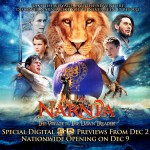
IRIDAS recently caught up with the team at TRIXTER to talk about one of their recent crowning achievements, Narnia: The Voyage of the Dawn Treader.
TRIXTER has quickly become renowned for their expertise in stereoscopy, their early experience with stereoscopic conversions, and their advanced in-house tools and standardized workflows. TRIXTER has also earned a reputation for managing conversion projects with extreme accuracy. Following a test project for MARVEL Studios, TRIXTER earned the confidence and trust of Walden Media and FOX Studios and earned a spot for the stereo 3D work on Narnia.
IRIDAS spoke with Michael Coldeway, president of TRIXTER, and asked him about their work on Narnia, the production pipeline they executed, and the challenges they faced.
What makes TRIXTER stand apart? What made TRIXTER so ideally suited for the conversion of Narnia?
I believe that one attribute that is not only unique to TRIXTER, but attractive to our clients, is that we do not use an automated process as part of our workflows. But rather, we select appropriate VFX techniques for each shot, be they projection, feature detection, motion detection, 3D point clouds, keying, cleanplates, and in combination with our proprietary stereo 3D pipeline tools.
We are first and foremost a VFX company. We’re highly experienced in solving problems creatively and technically. Before landing Narnia, we had already put several films in their entirety through our facility in various capacities; this means that our pipeline is proven and reliable, and we understand the realities of stereo conversion, post production and a deadline.
With our general understanding of storytelling and visuals, we now approach stereo conversion in a very unique way – it’s not necessarily about just rotoscoping everything, but using all the VFX tricks we’ve learned, we create a stereo volume which helps the narrative or mood of a scene.

